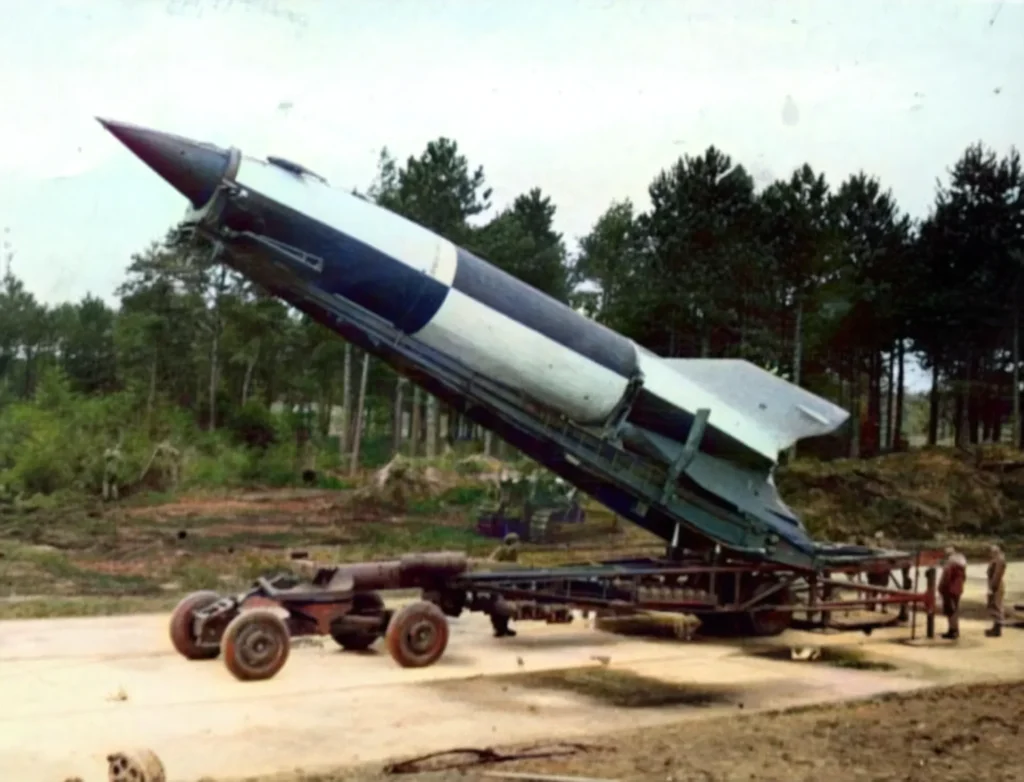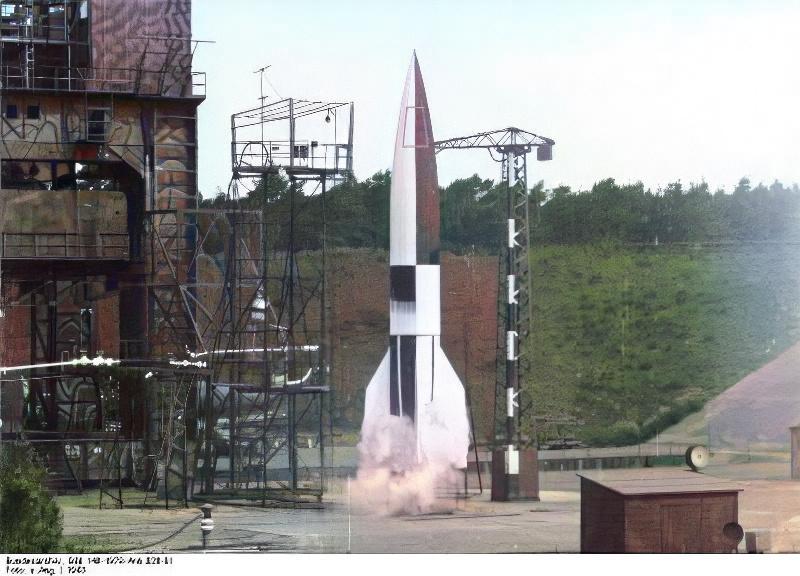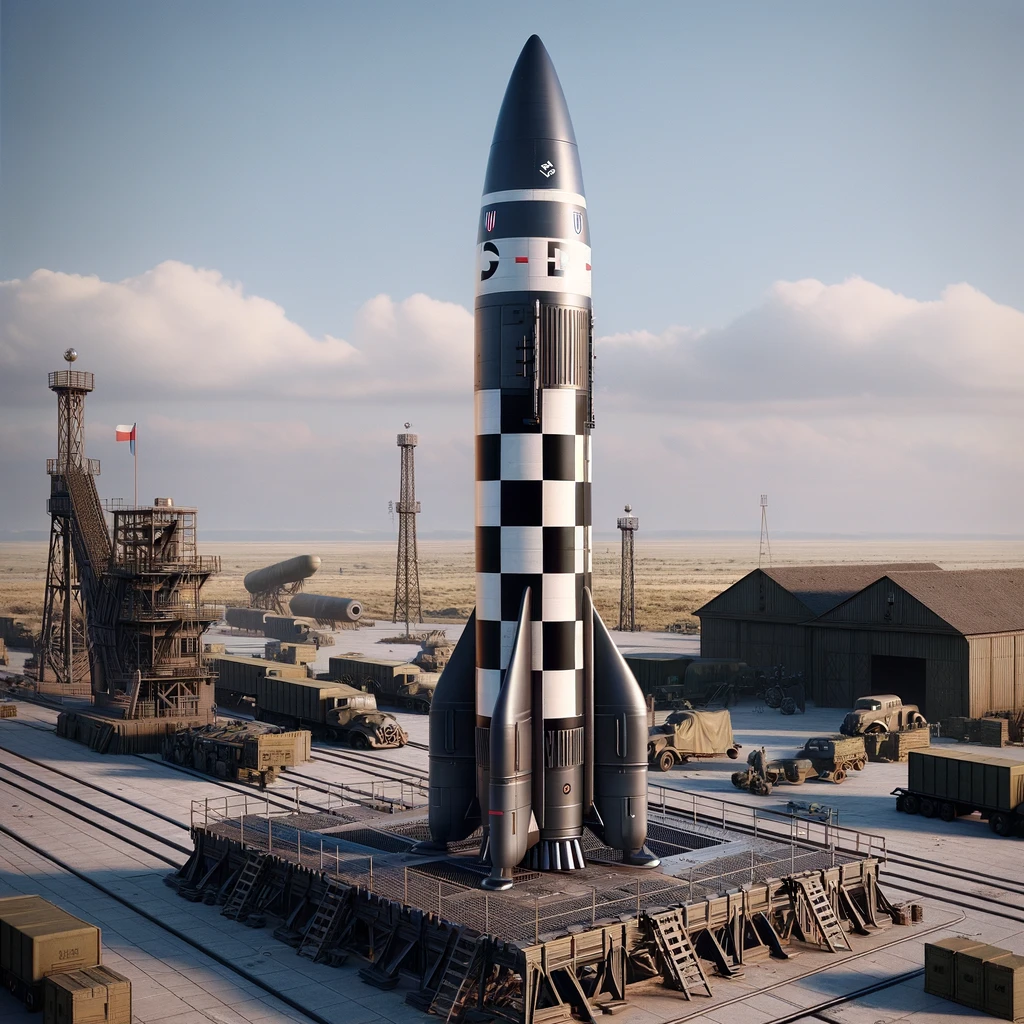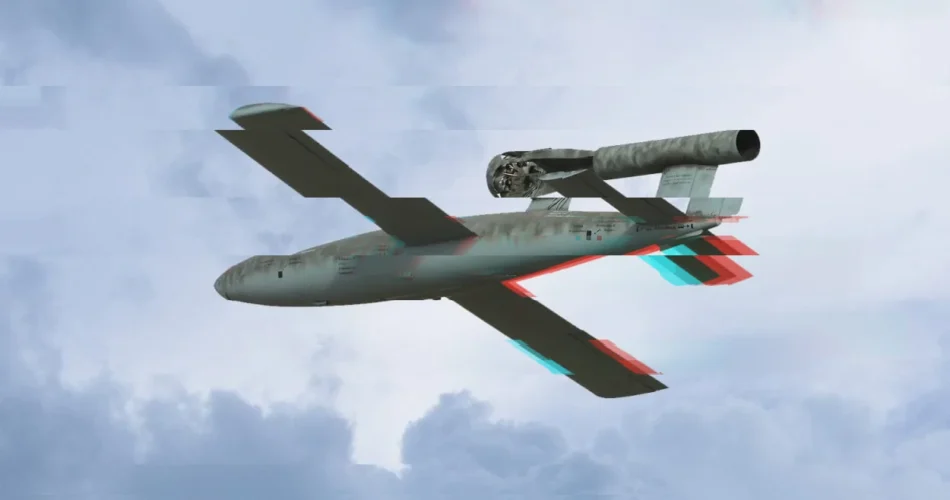What if Nazi Germany did invent the Ultimate Weapon? What if some clever scientist successfully built a missile that could carry tons of high explosives to any place, any city in the world? A weapon that fell from the sky without warning and at such high velocity that no one could hope to stop or intercept it. It’s a scary scenario, but perhaps even more scary is that they got close to doing this.
I’m Indy Neidell; this is a World War II in real-time special about the V2 Rockets. Okay, in the late 20s and early 30s, there was a real craze for science fiction in books and cinema, for the universe’s secrets. You had rocket-propelled cars, sleds, and planes breaking speed records and creating what in Germany was called the Rocket Rumble. For a bunch of engineers, scientists, and students of the small German Society for Rocketry in Space, the realization of interplanetary travel seemed only one major breakthrough away according to famous Professor Hermann Oberth’s theories. The future lay with large missiles powered by a liquid mix of oxygen and gasoline that reached beyond the Earth’s atmosphere. The problem was building such a missile not only needed the necessary brain power and enthusiasm but lots and lots of money and resources.

Then, in a time of mass unemployment, a tempting offer came from the German military. The Verein für Raumschiffahrt (VfR) weapon research department would provide everything they needed, from access to rare resources and fuel to the means of organization and administration, to a place where they could build and measure their prototypes. In exchange, they got ownership of everything: all patents, inventions, and intellectual property. Some scientists balked at this, but most of the brightest minds, like Wernher von Braun, agreed to join up.
Beginning in the summer of 1932 on the artillery range at Kummersdorf, the German rocketeers were set to follow the lead of Wernher von Braun, a 20-year-old prodigy in physics and astronomy. Although there were many prototypes with various specifications, the main goal would remain the same: building a light metal rocket able to cover a distance of at least 250 km while being no heavier than 12 tons nor longer than 14 meters. It was to be a liquid propellant, unmanned, self-guided missile that traveled at supersonic speed at the edge of the Earth’s atmosphere.
But while the scientists wanted to go to the moon, the military sought the ultimate artillery shell. The first of these rockets was rather modest yet promising. Aggregate 1 was just 1.4 meters long, weighed 150 kilos, and gave a thrust of 300 kilos but was somewhat unstable during flight. Trials A2 was already a major improvement, solving the stabilization problem not with a rotation top but a heavy centrifugal gyroscope inside. When shown to Adolf Hitler in October 1933, the Führer showed exactly zero interest in the whole idea, later even arguing that such a rocket would never take flight. Military men, however, were taking notes, and von Braun promised that they were just exploring the potential of such a missile weapon when it came to the range and the size of the impact.

Working with cutting-edge technology and with visionary goals in mind, the rocket program often required parts that had to be invented specifically, like more powerful fuel pumps that could accelerate the pressurized gases quickly enough. Most of it was miles ahead of what was available on the market, so planning, building, and testing went hand in hand. Millions of Reichsmarks had to be put into acquiring people, resources, laboratories, precision tools, and above all, a new place to try it all out.
They eventually found the perfect testing place on the Baltic island of Usedom, called Peenemünde. By November 1938, the rocket program had something to show: 50% of all new Aggregat-4s launched reached a range of 300 km and then came down within a 7 km range of the target. This got them the vital support of Albert Speer, who laid out plans to mass-produce the A4 as early as 1941, putting the rocket program on the same level of importance as the U-boats and the Ju88.
To distribute resources and skilled labor, the German war industry organized itself by levels of urgency, but the final word lay with the Führer himself. Every branch of the military needed precious steel, and Peenemünde required at least 6,000 tons a month to keep the 1941 plan going. Hitler only allowed them 2,000. Dornberger and von Braun repeatedly appealed to Nazi leadership, pointing out that while Germany was now far ahead in rocket science, the US and the USSR might catch up if they did not follow up on it but Hitler wanted a weapon he could use now, not in 3 years. The quick victories over Poland and France put the rocket program even further down the list, only to be brought back on top again as the Luftwaffe failed to win the Battle of Britain. Then, however, the invasion of the Soviet Union prioritized tanks and other such equipment, so it was backed down again.
And yes, this back and forth made it impossible to keep a consistent production schedule going, and things really stagnated. There was also competition from within; not only did the Luftwaffe constantly fight for resources for their planes, they also made a competitor to the A4, the Flugbombe Aisla Fi 103. This flying bomb was a pulse-jet propelled air torpedo, far cheaper to produce at only 35,000 Reich marks each compared to the A4’s 144,000. It also needed less steel and consumed less fuel of a lesser quality. The flying bomb, however, was much slower, produced a lot of noise, and was easier to spot on radar. The A4, though, did not need large installations to launch and was in principle impossible to shoot down once it re-entered the atmosphere, and it would hit its target with an immense force. Left with the decision over precious resources, Nazi leadership chose to continue both projects, of course pleasing absolutely no one.
Work on the A4, which propaganda began to call the V2 for Vergeltungswaffe or payback, continued, albeit very slowly, with von Braun trying to iron out the issues still plaguing the imperfect rocket-like stabilization, pathfinding, and a homogeneous burn of the propellant. The flying bombs, by the way, got the name V1. But V2 work would soon enough be interrupted again. In Autumn 1942, British intelligence was tipped off by a Danish chemist that the Germans were supposedly building a war-changing superweapon. After months of gathering evidence with aerial photographs of Peenemünde and reports from the Polish resistance as well as interrogation records, the British became seriously worried. Unlike the Germans, the British had experimented only with solid powder rockets, not liquid fuel, and underestimated the possible size and power of such a missile. Well, in August 1943, they launched Operation Hydra, which saw nearly 600 heavy bombers hit Peenemünde. 738 people were killed among them 178 scientists and more than 500 foreign workers. It was a major blow to the German rocket program, although not fully destroyed, the deaths of so many important scientists delayed the prototype once again.
However, in October, the remaining scientists around von Braun, Ti, and Dornberger were finally ready to reveal Aggregat 4 as a ready weapon. With a length of just over 14 meters and a diameter of 1.65 meters, the rocket could carry 990 kilos of explosives inside its head. The steel at the top of the rocket was 6 mm thick to withstand a temperature of 680°C during the re-entry into the atmosphere. Because of this enormous heat, the V2 could only carry regular explosives and not the much more volatile train. It was fueled by a mix of 75% ethanol, and 25% water, with liquid oxygen as an oxidizer. This had to be kept at a temperature of minus 188°C. The fuel and oxidizer pumps are driven by a steam turbine running on a mix of hydrogen peroxide and sodium permanganate. The hot gases of 385 degrees would bring the turbine to over 3,800 revolutions per minute. An initial thrust of 3 tons would ensure an even combustion and would then be raised to 25 tons in order to propel the rocket upwards. Azimuth and inclination gyroscopes control the graphite rocket steering paddle and stabilizers using electronic and hydraulic commands. The whole rocket was programmed to incline itself autonomously to the defined path. Once underway, it was impossible to influence the rocket’s trajectory as its fuel was cut off, it would automatically activate the fuse after a rise of 90 km. The rocket would then steer itself into its ballistic curve toward its target. The V2 would reach a maximum speed of 1500 meters per second after just 63 seconds. It was calculated that the impact of the rocket would lead to a crater 14 meters in diameter and 7 meters deep. This impressed the Führer who even admitted that he had been wrong and should have prioritized the program from the start. Now the V2 would only need to be mass-produced, and the war might be turned around. Easier said than done, though.

By now, Allied bombardment of production lines was bad enough that a V2, a rocket made out of 2,000 individual parts, had serious problems getting together. Peenemünde had to be given up, and a system of tunnels underneath the Hartz mountains at Nordhausen was chosen instead. Here, they set up Dora, a subcamp to the concentration camp Buchenwald, to house thousands of foreign resistance fighters and German Communists and employ them as slave labor. Living conditions were hell, sabotage was high, and punishment severe. By the end of 1943, more than 11,000 inmates were forced to work in an immense program to supply Nazi Germany with thousands of rockets. By May 1944, Hitler had green-lit the bombardment of London, though with the V1 flying bombs. As von Braun had feared, the V1s were much too slow and too easy to shoot down to be a true game-changer. By September, the V2 was ready to fall onto the British capital. Although the numbers killed were painfully low in comparison to the destruction British bombers were wreaking on German cities, there was indeed no way to counter the V2 at the time. The attack was sudden, silent, and with immense velocity and impact. The panic in London was real. Further V2s were fired against London and Antwerp, the latter the only tactical use during the war of the V2. But the rapid advance of the allies and their overwhelming aerial supremacy meant that everything was hit and run. One major benefit of the V2 was that it only needed a starting ramp to be set up; a 15-meter high crane could set up a V2 in less than 90 minutes. Around 2,700 people were killed in London and 1,700 across Belgium by March 1945 when the last V2s were fired.
Like with so many things in the Third Reich, the steadily worsening situation of the war made its leadership realize their misjudgments of the past. Then suddenly, in an effort to make good for the lost time, they would embark on a great rush to turn it all around, which of course was bound to fail. Germany was too far gone now, but even then, even then it was close. To give you an idea how close it actually was, one reason why Sandys got the approval of the bombing raid against Peenemünde was that he intentionally exaggerated the reach of the V2 to the Americans, spreading fear that New York would be within reach. The truth is, von Braun indeed had plans for such an America rocket already in 1940. He envisioned a 34-meter long intercontinental rocket and had already figured in the Earth’s rotation and curvature. Hitler simply disregarded it. Then there was the idea of putting V2s onto submarines, making intercontinental rockets obsolete as these could be fired from literally anywhere on the seas. It was difficult as heck to make such a configuration work, but by the end of 1944, they had done it. It was just too late to be used or prototype further.
The idea to create Flak rockets based on the V2, von Braun pictured a 7-meter long remote-controlled rocket that was able to find its target and detonate on its own. He estimated it would take two such unmanned rockets to take down one heavy bomber. Sounds revolutionary, right? By the end of 1944, they actually built and fired around 50 of them, and the estimations were correct, but there was simply not enough steel or graphite available anymore to mass-produce them. What do you think? Could Germany have been victorious if its leadership had invested in the rocket from the beginning, or was it all a major waste of money and resources that could have been spent elsewhere? Well, such discussions are what the comment section is for.
